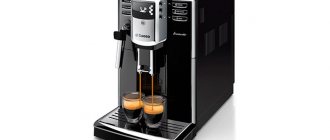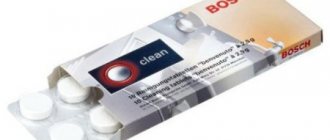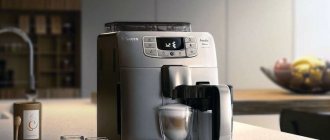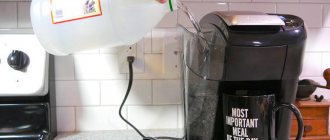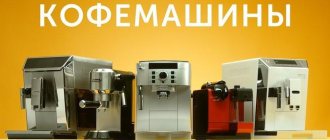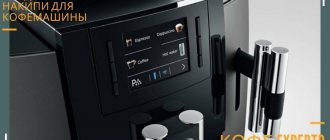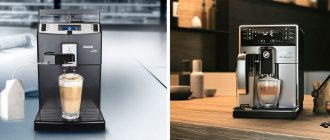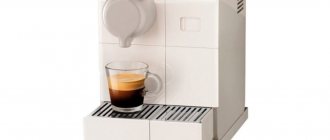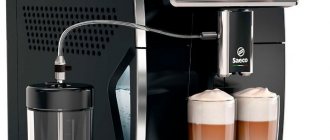Decalcification – this is the removal of calcium (scale, lime) deposits in the heating elements (heating element, boiler, thermoblock) of the coffee machine using chemical compounds (adipic acid). Essentially, this is simply running a chemical through the entire water supply system with short time delays.
The formation of salt deposits occurs throughout the entire hydraulic system, both before and after the heating elements. The higher the water temperature, the faster plaque formation occurs. At water temperatures below 40°C, the formation of salt deposits occurs many times slower, but still occurs. What we mean is that an unnoticeable deposit also forms in the water tank, which needs to be cleaned with a brush from time to time.
How to determine water hardness? In order to quickly determine the hardness of the water you pour into the coffee machine, just look into the kettle. A large layer of white deposits on the heating element indicates very hard water. Floating white or slightly yellowish flakes inside the kettle also indicate an abundance of calcium. If you are not using a kettle, put water in a dark-bottomed saucepan, place it on the stove and bring it to a boil. Let the water cool. If a white coating has formed on the walls and bottom of the pan, you already understand what this means.
How and from what does scale form?
We do not use sterile water for preparing food and drinks. Even filtered or bottled water contains a certain set of minerals. These include calcium, magnesium, iron. When water is heated, some of these minerals form an insoluble precipitate that remains at the points of contact between the heating elements and the water. Over time, sediment accumulates, the layers harden and form a crust. It's called scale. The more impurities in the water, the faster scale forms.
Scale can form in a coffee machine even from filtered or bottled water. The harder the water, the faster scale forms.
How often to do a decalcification program
It’s worth considering whether everything is okay with your device as soon as you notice that:
- the flow of the finished drink fades away;
- the foam ceases to be fluffy and thick;
- The resulting coffee turns out barely warm, and its delicate and pleasant taste deteriorates.
It might not hurt to clean the machine of oily coffee deposits and scale. After all, these factors negatively affect the heating and supply of the drink and even block the internal parts of the device.
So, in order to prevent this, we recommend removing formations at regular intervals, the frequency of which depends on the degree of hardness of the water consumed.
Reference. To find out what level of water hardness you have, do a test. Take a special test strip and dip it in the liquid. The degree of color will indicate the concentration of calcium in the water.
There are options for coffee machines with automatic detection of water hardness level. For them, it is enough to specify the parameter once in the coffee machine menu, and the program will remember it. However, in the absence of instructions, the machine will operate at the factory setting. That is, you will have to clean the device after each boiler containing 30 liters of water is poured.
When the water hardness level is within normal limits, the coffee device will require cleaning only after using 120-240 liters of water.
The conclusion follows from this: so that the coffee machine does not require descaling ahead of time, it must be adjusted in accordance with the actual degree of water hardness. The harder the water used to prepare the drink, the more often the device should signal the advisability of descaling.
It is important for coffee machine users to monitor the quality of the prepared drinks and even wash them ahead of time if necessary. A simple way to recognize when cleaning is due is the presence of white sediment in the mug.
What is decalcification of a coffee machine?
The basic element of scale is calcium salts. They have a loose, porous structure and easily add other elements from the water: iron, magnesium, potassium, fluorine. Decalcification is the removal of mineral plaque by softening the calcium crust. It is impossible to scrape off plaque by mechanical means. Rough intervention is dangerous as it can damage the heating elements of the coffee machine.
Therefore, decalcification is carried out using special means that react chemically with calcium salts. As a result, the crust softens, crumbles and is easily removed with water. Modern industry produces ready-made products to combat plaque. Some coffee machine owners prefer traditional, low-cost life hacks that help deal with this problem.
What happens if the coffee machine is not cleaned?
Any water other than distilled water contains minerals and chemical elements. The main one is calcium. When water is heated, calcium salts precipitate, forming limescale.
The surface of the scale is porous; salts of other metals settle on it, and over time, microorganisms can multiply in these pores. All this negatively affects the technical condition of the household appliance and the taste of coffee.
The main signs of scale appearance:
- change in the smell of the drink, it becomes unpleasant;
- getting cereal into a cup;
- the feeling that the coffee has not been brewed enough, its strength has become less;
- reduction of steam pressure;
- weakening of the drink stream, this applies to a lesser extent to coffee machines with a boiler as a heating element; the likelihood of blockages is lower than for models equipped with a thermoblock;
- changing the sound of the coffee machine during operation.
Some modern appliances are equipped with sensors for automatically checking the scale level; a notification appears on the panel that the coffee machine needs to be decalcified. This warning must not be ignored. Even if automatic blocking does not occur, the device may soon fail.
Why is decalcification necessary or why is scale dangerous?
Limescale in a coffee machine is dangerous both for equipment and for humans. Deposits cause problems with the heating element. In a coffee machine it is very small, so even minor interference will interfere with its effectiveness. The scale forms a kind of coupling around the heating element, interfering with heat transfer. The result is a double negative effect.
- The heating element overheats and can burn out from excess heat
- The coffee water is not hot enough.
Insufficiently heated water does not do a good job of brewing coffee; the drink turns out sour, weak and cloudy due to underextraction.
Repair shops will tell you cases where not only heating elements, but also the entire body of the coffee machine suffered due to limescale deposits. Over time, lime corrodes fastening and connecting elements.
How else is scale dangerous?
- Blockage of the water passage in the system.
- Blocking the tap through which coffee flows into the cup.
- Getting into a cup of coffee.
- The proliferation of bacteria that thrive in the loose structure of limescale.
Decalcification extends the life of the coffee machine and allows you to prepare tasty and safe coffee.
Signs of a clogged coffee maker
When using water containing hardness salts, scale will inevitably form in the coffee maker. Both simple drip and capsule or carob coffee makers are susceptible to clogging.
The more bends and smaller the diameter of the tubes for the passage of water in the coffee maker, the greater the likelihood of scale formation. Lime scale particles clog water flow channels.
Not all coffee makers are equipped with a built-in indicator (a counter for the number of cups of coffee brewed), so you need to be able to recognize signs of limescale deposits inside the machine:
- It takes longer to prepare one serving of drink than before;
- if the tube and outlet are clogged, the stream of ready-made coffee becomes thin, causing the cup to take longer to fill;
- the taste of the drink has deteriorated;
- there is a foreign smell;
- the operating device began to make unusual sounds;
- a light gray sediment is visible in the cup;
- Electricity consumption has increased while the coffee maker is operating.
According to repair specialists, boiler-type capsule and carob coffee makers are most susceptible to heater overgrowth and tube clogging. In devices with a thermoblock, water does not stagnate, and the process of scale formation proceeds more slowly.
If limescale deposits have appeared, you need to get rid of it, and descaling the coffee maker is also possible at home.
In very advanced cases, the coffee maker will have to be disassembled
When should decalcification be carried out?
The timing of the decalcification procedure is indicated in the instructions for the coffee machine. Automatic coffee makers can themselves report the need for a procedure. You should not think that the machine evaluates the state of the water and its elements. It is programmed to decalcify after a certain number of cups of coffee are prepared. All machines are designed for use with hard water.
If your machine is not equipped with reminder functions, and the instructions do not contain anything about decalcification periods, then rely on the following recommendations from service specialists.
- If you only use bottled water, you can decalcify once every 10-12 months.
- If you use filtered water, then decalcification should be done every 6-8 months.
- If your area has hard water and you use a filter, then decalcification should be done after 4-6 months.
- If your area has hard water and you do not use a filter, then decalcification should be carried out every 3-4 months.
Indirect signs of the need for decalcification may include:
- musty smell of coffee;
- increased machine noise;
- foreign impurities in coffee.
Cleaning procedure
The easiest way to descale a coffee machine at home is to use special products – decalcifiers. For example, for devices from Delonghi, you can use a special descaling liquid EcoDecalk or a cleaning product for the cappuccino maker SER301, developed by the same brand. Recommendations for use and dosage are always indicated in the instructions for solutions or tablets. Follow these instructions strictly.
The procedure is as follows:
- Fill the water container about halfway. The liquid should not be hot.
- Dissolve a special product in water.
- Place a bowl or small basin in place of the cup.
- Place the water container in place and drain approximately 100 ml of liquid through the hot water pipe.
- Turn off the device and leave it for 15-30 minutes.
- Start the appliance and drain the remaining water.
- To clean the parts of the coffee maker directly involved in preparing the drink, prepare several cups of coffee ( of course, you won’t be able to drink it, since special chemicals are dissolved in the water ). The powder is not poured into the carob devices during the run.
- Don't forget to rinse the water container after finishing cleaning by thoroughly wiping its walls with a soft sponge.
- Fill the container with clean water and run it through the system. It is advisable to perform this procedure twice. This will remove loose deposits from the device.
If you don’t have special products on hand or their prices are prohibitive, you can descale your coffee machine with citric acid . To prevent the home remedy from causing harm, do not exceed the following dosage: 30 g of powder per 1 liter of water. Under no circumstances should you use acetic acid or, for example, Coca-Cola to flush the system. The rubber parts of the device may not withstand such treatment.
Otherwise, the cleaning procedure using citric acid will be exactly the same as when using special products. Provided that everything is done correctly, lime deposits and traces of oils are dissolved and removed from the equipment.
Monitor the condition of your equipment, maintain it on time, then every morning will begin with aromatic, invigorating and tasty coffee.
Coffee machine decalcifiers
There are many means for decalcifying a coffee machine, which can be divided into specialized and popular ones.
Specialized decalcification products
Specialized preparations for decalcification are produced in the form of liquid and tablets.
Liquids are sold in bottles for 1-2 uses. Many manufacturers of coffee equipment prescribe in their instructions the use of only branded products of the corresponding brand: Bosch or Saeco.
There are multi-brand liquids for universal use, for example, Top House or Filtero.
The compositions of all products use the same active substances, so it is quite possible to use any universal product for decalcification.
Tablet preparations differ in the form of release and the concentration of active substances. One or two tablets are usually enough to clean the coffee machine. Tablet products are cheaper than liquid ones.
Folk remedies for cleaning coffee machines
These include citric acid. An acidic environment softens calcium deposits well. The acid is diluted at the rate of 10 g per 1 liter of water and the resulting solution is used.
Citric acid is inferior in effectiveness to specialized products. Some experts consider it too aggressive for the heating element and the body of the coffee machine. The use of citric acid can damage the protective coating of heating elements and they will begin to rust.
No other types of acids can be used for decalcification, not even the popular acetic or oxalic acids. They are too aggressive for the internal structure of the coffee machine.
Care and prevention measures
It is always easier to prevent a problem than to solve it later. Proper handling of your coffee machine will save you from premature breakdowns and expensive repairs.
Follow these guidelines:
- First of all, carefully read the instructions for the product if you have not already done so. The manufacturer describes in detail the operating and maintenance conditions of the device.
- Use well filtered water. And even better - bottled.
- Keep your coffee machine clean. Periodically wipe the housing with a damp and then dry cloth. Keep the spout from which the coffee comes out clean.
- Regularly clean the main components of the machine, remove scale, remaining oil, milk, and coffee grounds. For these purposes, use special products from the equipment manufacturer or those offered on the household chemicals market.
- Enter data on the hardness of the water used in the coffee machine menu. The system will notify you about the need to descale the product.
- The cappuccino maker should be regularly purged and milk deposits removed from it. It is recommended to wash it immediately after preparing milk drinks.
How to descale a coffee machine?
Automatic coffee machines in the high price segment have special cleaning programs. You need to pour liquid descaling agent into the machine and run it in the desired program. If you are using tablets, the drug must be diluted in water according to the instructions and, after complete dissolution, the tablets must be used in the same way as a liquid product.
In some models, a special program is not provided and cleaning is performed in a sequence of actions. The entire procedure is described in the instructions for the coffee machine.
Semi-automatic and many automatic coffee makers are cleaned by simply running the coffee program. Do not add grains; instead of water, add cleaning liquid or a tablet diluted in water. The resulting “drink” is immediately poured out and the procedure is repeated with plain clean water, without any means.
The decalcification procedure is always described in the instructions for the coffee machine. Therefore, strictly adhere to the sequence of actions. The only place where deviation is appropriate is the choice of means. You can take a generic one rather than a branded one, or replace the liquid with tablets.
Types of decalcifiers
Manufacturers offer branded cleaners for their coffee machines, which are quite expensive. As a rule, companies do not produce decalcifiers themselves, but enter into partnership contracts with manufacturers of household chemicals.
Since all drugs act in a similar way, you can effectively clean the device using universal products. The main thing is that their use is acceptable for automatic coffee machines.
Types of decalcifiers:
- powder or tablets;
- concentrated liquids;
- cleaning capsules for capsule-type coffee machines.
Liquid coffee machine descaling agent is designed for one or two applications. Tablet preparations are more economical, since no more than two tablets are required for one-time cleaning.
How much does decalcification and refusal cost?
The most painful issue is financial. Many people think that decalcification is too expensive. Let's do the math.
- 800-1200 rubles for a bottle of branded cleaning liquid. It is enough for 1-2 uses.
- 150 to 500 rubles per bottle of a universal product.
- 200-450 rubles per pack of tablets, one tablet – one cleaning cycle.
We find that the cost of a cleaning “session” ranges from 50 to 600 rubles.
How much does it cost to not descale your coffee machine?
A burnt heating element will lead to replacement of the boiler, and this costs from 8-10 thousand without transportation costs.
Why citric acid?
Citric acid can be found in any grocery store in the form of colorless, transparent crystals or white crystalline powder with a sour taste. It is a natural, harmless to humans and the environment product that copes well with the effects of hard water. It dissolves perfectly by heating at temperatures above 74 degrees Celsius and perfectly removes scale from the coffee machine:
3 CaCO3 + 2 C6H8O7 - Ca3(C6H5O7)2 + 3 H2O + 3 CO2
When citric acid (C6H8O7) reacts with calcined compounds (CaCO3), sodium citrate (Ca3(C6H5O7)) is obtained, which dissolves in water.
The benefits of using citric acid to descale your coffee machine are:
- friendly nature – does not cause environmental pollution, does not contain toxins;
- mild action – does not harm human health upon direct contact, does not emit toxic fumes;
- Powerful cleaning process – even a small amount of powder can clear away long-standing build-ups.
How to clean a coffee machine manually
When your coffee machine doesn't have an automatic cleaning option, you'll have to do a little more work to clean the machine.
You need to descale your coffee machine and remove coffee oils that accumulate in the brewing unit of the coffee machine. In coffee making machines, a distinction is made between a removable brewing unit and a non-removable one. For example, in carob-type coffee makers, it is the horn that performs the function of the brewing unit. To clean it, you need to remove the horn and place it in a solution with a cleaning agent, then rinse thoroughly under running water. You can also wash the water supply container.
If your coffee machine has a built-in brewing unit, it is cleaned automatically. You need to load the tablet into the ground bean compartment and press the button to prepare from ground beans. Before doing this, pour approximately 2 liters of water into the device. All liquid that comes in should be poured out. When the device finishes working, let it stand for 30 minutes, and then rinse with water.
To clean capsule coffee machines, a tablet specifically designed for this type of device is also used. The tablet is loaded into the capsule compartment and the normal coffee preparation mode is activated.
How to know when it's time to clean your car
Agree, there is nothing worse than making yourself a cup of espresso and suddenly realizing that the coffee is sour and has a rancid taste. If your coffee machine has always made the best coffee in the world, and one fine morning everything went wrong, then it’s time to clean your machine. But the taste of coffee is far from the only sign that equipment needs deep cleaning.
Typically, coffee machine service specialists recommend cleaning once a month if the water hardness level is normal, but if the water is hard, cleaning should be done more often.
Nowadays, many coffee machines will let you know when it’s time to clean them. Such machines have a special indicator built into them, which, after preparing a certain number of cups of coffee, will begin to flash and indicate that it is time to clean the machine.
If your coffee machine does not have such a function, you will have to determine the need for cleaning yourself. It's easy to do:
- The taste of coffee changes. It becomes sour with an unpleasant bitterness
- Scale deposits appear at the bottom of the mug after drinking coffee
- The water heating time has increased, and the coffee is pouring into the cup with difficulty in a slow stream.
- The device began to operate louder and crackling.
These are indicators that it is time to clean the coffee machine.
Features of automatic cleaning
Many coffee machine models have an additional “Auto Clean” function. Its presence greatly simplifies the process of decalcifying the device, but it is important to know the specifics of its implementation. Usually, the device is additionally supplied with instructions, which fully describe the entire process of descaling.
Below are recommendations that will help you correctly perform automatic descaling:
- You need to pour clean water into the water purifier container;
- tablets are placed in the cleaner compartment or cleaning liquid is poured;
- The auto-cleaning mode is turned on and the device is left for a while;
- After about 10 minutes, the scale will completely come off. The device turns off, everything is drained from it;
- Next, you need to remove any remaining cleaning liquid or tablets. To do this, you need to boil clean water 2-3 times;
- Afterwards, coffee is brewed three times, but you cannot drink it.
Washing the coffee maker elements
Automatic cleaning is not performed too often, once a month is enough. During this process, you also need to rinse the body, cappuccino maker, drip tray, and waste container.
How is manual cleaning done?
In any case, the owner of a professional machine must regularly clean the equipment manually. It is recommended to come to this procedure at least once a month. How to properly descale a delonghi coffee machine:
- Machine instructions - describes in detail which parts can be removed and which parts cannot be touched.
- Allow time to clean and assemble the machine.
The compositions of all products use the same active substances, so it is quite possible to use any universal product for decalcification.
The process itself will not take much time:
- The filter and containers are removed and treated to remove any remaining grounds.
- If you use gel, it should be poured into a water container. Many of them are concentrated and require dilution with water.
- Using the correct heating temperature also depends on the cleaning product used.
- Next comes the drain. Usually – 250 ml.
If your area has hard water and you do not use a filter, then decalcification should be carried out every 3-4 months.
Important! It is advisable to do the spilling in small doses, every 5 minutes.
The tablet's action process is similar. Each piece is dissolved in water in advance, after which the usual spill is performed.
Automatic coffee makers can themselves report the need for a procedure.

